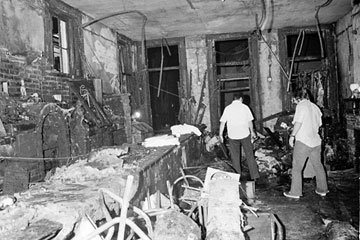
This is a view inside the UpStairs bar following a flash fire that left 29 dead and 15 injured, June 25, 1973. Most of the victims were found near the windows in the background. The bar is located in the New Orleans French Quarter.
(2 of 5)
And then it was over. Firefighters extinguished the blaze 16 minutes after receiving the alarm. Twenty-nine people burned alive that night; three more died soon after. Many could be identified only by dental records. A Times-Picayune headline called the scene "Hitler's Incinerators." But it made little more than a ripple in the national consciousness. Neither the mayor nor the governor spoke out, local religious leaders were mostly silent, and only one congregation in the French Quarter ultimately agreed to hold a memorial service. A two-month police investigation turned up a can of lighter fluid at the scene and a thrown-out patron overheard threatening to "burn this place down," but no one was ever prosecuted. Dufrene puts it bluntly: "I guess they figured, They were gay--so what?"
The scale of the tragedy was immense: it remains the deadliest fire ever in New Orleans and is believed to be the largest killing of gay people in U.S. history. And yet it is little discussed, barely acknowledged by the city or seen as a milestone in the gay-rights movement. Today the site is marked only by a square brass plaque on the sidewalk where the bar's entrance used to be. It's easy to miss unless you're looking for it--a fitting commemoration for an event not everyone wants to remember.
Persecution Days
The Jokes began almost immediately. The Rev. Troy Perry, founder of the MCC, flew in the morning after the fire and remembers a radio host asking on air, "What do we bury them in?" The punch line: "Fruit jars." The police department's chief of detectives reinforced the homophobic climate when he told reporters that identifying the bodies would be tough because many patrons carried fake identification and "some thieves hung out there, and you know this was a queer bar."
Despite the city's reputation for tolerance, there were consequences to being gay there in 1973. One victim, a teacher, was fired while in critical care at Charity Hospital after his school learned that he had been at the bar. He died days later from burns. Many of those killed and injured were effectively outed when the papers published lists of the victims. Two survivors appeared on television on the condition that their names and faces would not be revealed. Others had to go to work on Monday morning as if nothing happened.
Duane Mitchell, then 11, and his 8-year-old brother Steve knew something was wrong when their father never came to pick them up. They watched a movie, Disney's The World's Greatest Athlete, seven times before realizing he wouldn't show, Duane says. Mitchell had escaped the blaze by following Rasmussen out the back door, but he ran back in to retrieve Broussard. Police found their bodies fused together, dead in each other's arms. "We didn't even know that he was gay," Duane, now 51, says of his father. In 1973, he adds, such things were barely discussed. "A lot of people didn't even claim their relatives," he said. "I guess they were so ashamed of it."
